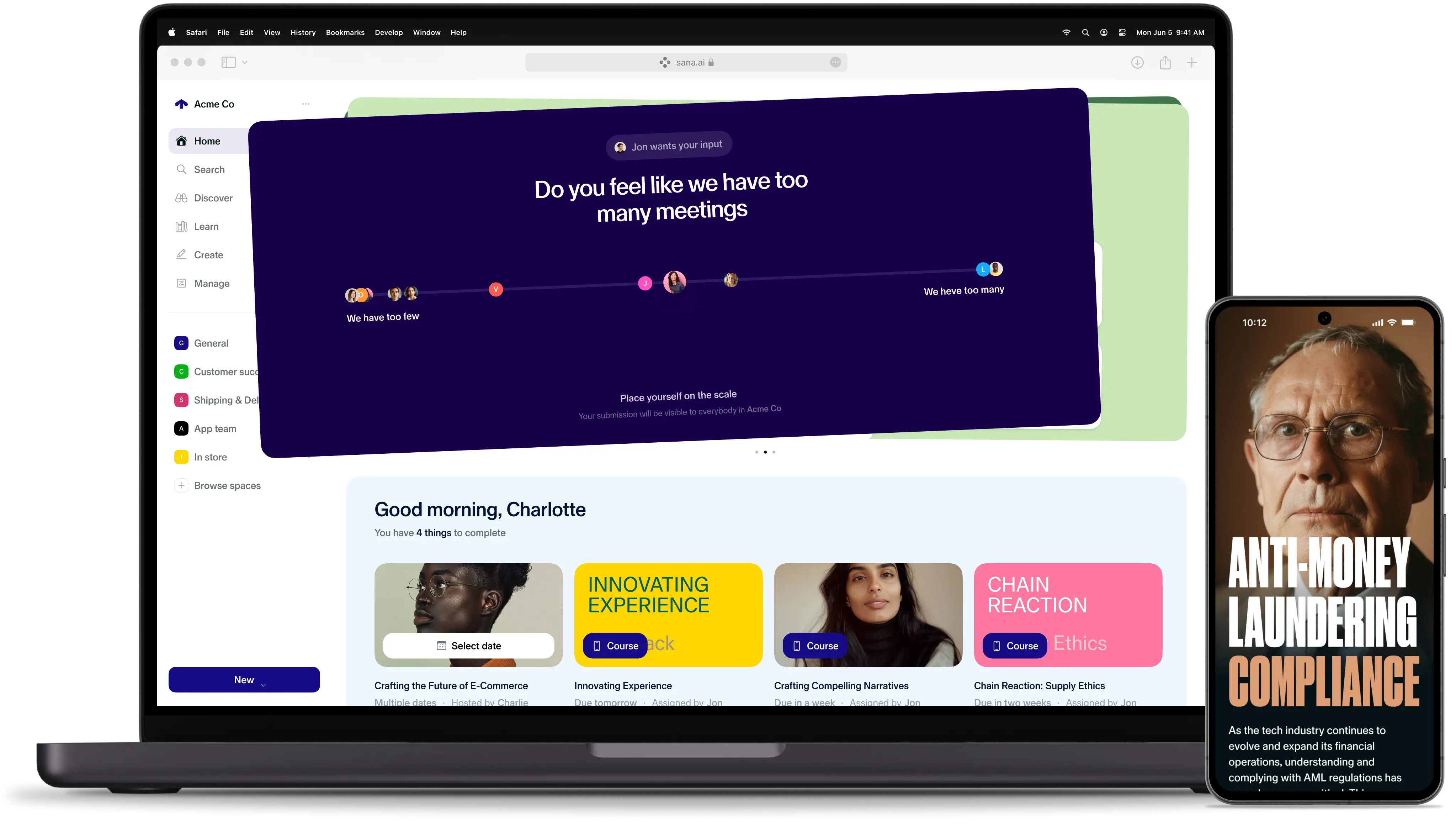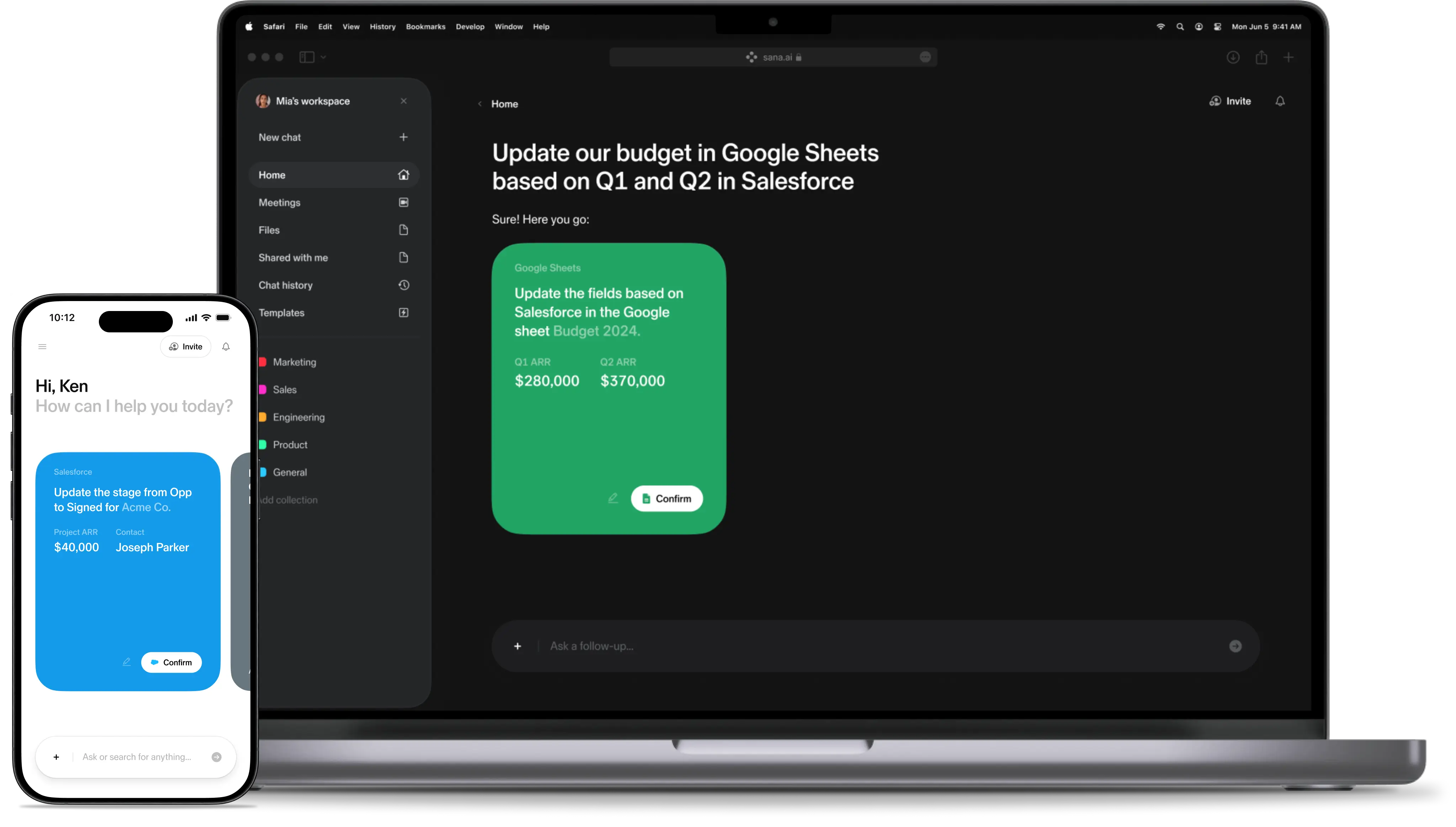The synthesizing mind. How to hire and nurture talent in the era of AI.

AI has immense potential to augment the workforce and unleash untapped productivity and innovation. But only if we have the right talent to question, understand, and embrace this technology. To do this, we need to hire and train people to have ‘synthesizing minds’.
I’m AJ Josephson, I’ve helped companies including Miro and Salesforce scale through times of radical change. And I’ve found that understanding our synthesizing mind (SM) might be the red thread to guide us through this global upheaval.
The AI age needs synthesizing minds
The game has changed
AI is transforming the People Playbook in real time. As the cost of knowledge access drops radically, AI-augmented workforces will adapt their skills from knowledge-retention to knowledge-application. Employees will shift from repeatable outputs to identifying new problems and generating cross-domain ideas that solve those challenges. The cost of prototyping and experimentation will drop. Creating something entirely new becomes cheaper and easier.
How do we prepare our employees for this shift? Enter: the synthesizing mind.
Win by a mile
People with synthesizing minds have “the capacity to take in a lot of information, reflect on it, and then organize it in a way that is useful to you and… also proves useful to others.” It’s a term coined by Harvard professor Prof. Howard Gardner. And it’s changed the way we can think about intelligence.
In other words, SM is all about taking diverse knowledge and creating new ideas, contrasts, and questions—generating something new and helpful for your world.
The process of synthesizing can be seen in three phases. When presented with a challenge, synthesizers are likely to:
- Source knowledge from diverse disciplines and perspectives
- Analyze contrasts and connections to create a new solution
- Articulate this new perspective accurately and effectively
People with higher levels of SM are ready to thrive in an AI-augmented environment. They cherish the thrill of extracting knowledge, applying ideas across disciplines, and sharing their new ideas and learnings with their peers. They become engines for innovation. In the age of AI, where more repetitive tasks are open to automation, the SM skillset is a critical business advantage.
The AI advantage
AI has the potential to make organizations radically more productive and innovative. But only if employees know how to use the tools effectively and wisely. This is why employees with high SM are so valuable; they have the skills to both exploit and question the technology.
Mitigating AI-generated risk
One of the biggest risks for early AI-adopters come from AI hallucinations. Generative AI works by taking a "fuzzy snapshot" of thousands of answers on a topic, and packages them into a clear and confident-sounding answer. Progress in GPT-4 has resolved some issues but hallucinations are still commonplace. This is where skilled synthesizers can catch and work around these problematic outputs.
AI hallucinations are especially risky for legal teams. Take the example of crossing markets. Generative AI can create basic contracts, but they need to be equitable and legal. Failure to comply with regional legislation is an expensive risk.
A person with high levels of SM might take AI-generated contracts, review them, and quickly check for accuracy, understand where a junior needs to confirm or amend details, and where deeper research is needed. They’ll improve upon the content, organizing the information carefully for their colleagues, and ultimately de-risk the final output.
Read:
The role of delight in product development
Read articleTake the example of product innovation. A skilled synthesizer is well-equipped to use AI tools to research from broader sources, consolidate product scoping, screen ideas, and evolve concepts faster. But they are also set up to accelerate the human relationships that exist at the heart of design. Being able to draw from different perspectives and disciplines energizes the discovery, idea generation, and testing phases with diverse customers and colleagues across departments.
Uncovering the talent within
Watching skilled synthesizers pull the one golden nugget of information can feel like magic. But assessing, interpreting, and applying complex information from across domains to find new insight is an infinitely learnable skill.
If you work in a scaleup, chances are you have plenty of synthesizing minds already in your organization. It’s never been more important to identify these individuals and empower them to coach SM skills in others. In the AI era, high SM employees are a key component to your competitive advantage. Here are three steps to help.
1. Find your synthesizing superheros
You’re looking for the t-shaped problem-solvers. The people who are comfortable with combining and analyzing a diverse range of data and information, regardless of their domain expertise. Product and Customer Experience teams are likely to have SM skills, but not exclusively. To shortcut the search, start by asking all team leaders for a list. Then invite a few to a 15-minute chat and learn more about what makes them tick. You want these employees to become your ambassadors.
2. Decentralize synthesizing training
Once you’ve identified your high SM employees, empower them to pass on their skills informally and formally. Ask them to host a Lunch and Learn; help them create a course. Here, a platform like Sana is powerful because you don’t need to be an L&D expert to produce an effective workshop or course. The editor is intuitive and the AI assistant supports with writing, editing, even generating relevant interactive polls and quizzes. Whatever approach you take, make sure the C-Suite is behind you. They need to champion this initiative and celebrate the high SM employees spreading their knowledge.
3. Unlock company knowledge
SMs are at their best when analyzing information. But, most organizations are struggling to harness their knowledge. From Google to Notion, Slack to Teams, insights and ideas are being lost. The result? Slowing your SMs down and hindering their productivity.
Sana AI solves this by integrating with all your companies apps, enabling employees to find exactly what they need and get to more relevant insights faster. Think ChatGPT for all your company’s knowledge. Make sure your employees aren’t some of the 46% who are using AI without their employer’s consent, pasting in proprietary information and risking data leaks.
Hiring AI-enabled A players
If you’re nurturing SM within your organization, you should be hiring for it too. In my experience, there are three key behaviors that you should be interviewing for. And when you assess these behaviors within a standardized process, you increase your chances of success.
Testing for SM behaviors
Structured interviews with evidence-based assessments are the gold standard of hiring. But in the rush of startup life, the work of making time to write questions, understand the answers needed, and briefing the interview panel can feel like wasted time.
One of the best ways to assess these behaviors is through a hypothetical work challenge or case. Imagine you're trying to hire a new department lead. To test for SM, you could give all candidates the following challenge:
The SM work challenge
Your task is to find a common practice used to motivate teams outside of your department and then develop a new approach to motivate your department To complete this challenge, you can do the following:
- Ask scoping questions
- Research with ChatGPT/Bard
- You will then present your findings and answer some questions
You would give the candidate approximately 20 minutes to prepare for this challenge before assessing them in a structured way.
Identifying the 3 SM behaviors
Interview panels on the hunt for stellar SM hires should be looking for candidates that demonstrate the following behaviors. They’re key to Gardner’s thesis:
Asking motivated questions: "Synthesis depends crucially on the quality of the questions asked and on the reasons that they are being asked."
Building analogies across contexts: "Seeing parallels, drawing connections, noting contrasts, making comparisons in a relatively discipline-free or pre disciplinary way."
Engaging with criticism: "Go deeper, provide more details, handle challenges, realize when a criticism is valid as opposed to being irrelevant or based on a fundamental misunderstanding."
Scoring the 3 SM behaviors
To make it easier to uncover synthesizing minds, I’ve created a rubric. The rubric contains a customizable challenge scenario and maps how the three behaviors look at different levels of skill.
Below the bar: Does not ask sufficient basic scoping questions, doesn’t identify relevant similarities or contrasts between seemingly unrelated things, and, when the panel challenges their answers, the candidate doesn’t go deeper or provide more details.
At the bar: Asks sufficient basic scoping questions for the task, makes comparisons, noting similarities and contrasts, and, when the panel challenges their answers, the candidate goes deeper, provides more details, handling challenges effectively.
Above the bar: In addition to the behaviors ‘at the bar’, the candidate ask questions that demonstrate early thinking about solutions and testing hypotheses. They adapt concepts or insights from one context to another, showing awareness of differences and similarities. Finally, candidates with high levels of SM identify when a criticism is valid as opposed to being irrelevant or based on a fundamental misunderstanding, and are able to articulate why a criticism is valid or not.
With a standardized process across all interviewers, you’ll increase your chances of hiring the best employees to take your organization forward.
Synthesizing for good
In the middle of the 20th Century, we began a collective shift from industrial society to an economy centered on information technology. The nature of work and structure of companies were utterly transformed as technology evolved over decades. We are in the early hours of a similar shift, but one that will occur at the speed of the information age we are now closing.
Just as the information technology swept away certain kinds of work and hyper empowered others, so will this AI age. The individuals and organizations that harness it will be super-empowered to do more, bigger, and—I hope—better than our forebears. Harnessing such transformational technology not only for innovation and efficiency, but also for the greater good, would be a truly worthwhile synthesis.
Next up:
The L&D leader’s guide to AI in the digital workplace
Read


